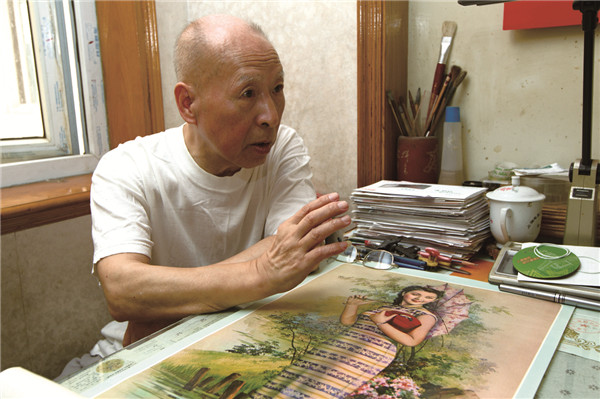 |
|
Jin Peigeng, son of Jin Meisheng, talks about special techniques in calendar painting. [Photo by Gao Erqiang / China Daily]
|
Jin the painter
Due to its massive demand, calendar painting quickly developed in Shanghai in the 1930s and some artists started setting up their own studios to capitalize on the boom. The profession was a lucrative one, too-during a time when the average monthly income of a middle school teacher was between 50 and 140 yuan, a painting by a well-known artist could fetch as much as 500 yuan. But creating top notch work was time consuming as well, and a piece could take as long as a month to complete.
Some of those who could command such fees were artists like Jin Meisheng (1902-1989). Jin started learning about water color painting in 1919 from a master craftsman named Xu Yongqing and he gradually developed interests in calendar painting after working in a publication house. He had five sons, but Jin Peigeng was the only one who followed in his father's footsteps. They became the only father and son duo in Shanghai specializing in calendar painting.
"Ladies in Four Seasons" was one of the most popular art works by Jin, whose many other creations had print runs of over 1 million. Peigeng revealed that though his father had painted countless portraits of beautiful women, none of them were actually based on a real person.
"My father didn't invite models to his studio as society was not that open-minded. Instead, he got his inspiration from magazines, or based his paintings on his imagination," Peigeng said. "The ladies who were created from his imagination were the best-looking ones."
One of the special skills that the Jins used in their work is called stumping, a combination of traditional Chinese and Western painting techniques. They would first sketch the subject using a pencil before using a modified wool brush to carefully rub stumping chalk powder on the paper, creating a shadow effect that makes the illustration look three dimensional, an element that is absent from traditional Chinese paintings. The artist would then use watercolor to add vibrancy and realism to the work.
"Good artists only used imported materials and tools like paper, colors, powder and painting brushes," Peigeng said.


























 Raymond Zhou:
Raymond Zhou: Pauline D Loh:
Pauline D Loh: Hot Pot
Hot Pot Eco China
Eco China China Dream
China Dream China Face
China Face






